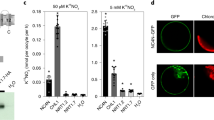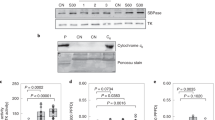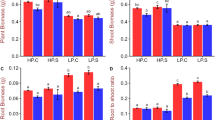Abstract
The green revolution’s breeding of semi-dwarf rice cultivars in the 1960s improved crop yields, with large increases in the use of nitrogen (N) fertilizer. However, excess N application has caused serious environmental problems, including acid rain and the eutrophication of rivers and oceans. To use N to improve crop yields, while minimizing the associated environmental costs, there is a need to produce crops with higher N-use efficiency and higher yield components. Here we show that transgenic rice overproducing ribulose 1,5-bisphosphate carboxylase–oxygenase (Rubisco)—the key enzyme of photosynthesis—exhibits increased yields with improved N-use efficiency for increasing biomass production when receiving sufficient N fertilization in an experimental paddy field. This field experiment demonstrates an improvement in photosynthesis linked to yield increase due to a higher N-use efficiency in a major crop.
This is a preview of subscription content, access via your institution
Access options
Access Nature and 54 other Nature Portfolio journals
Get Nature+, our best-value online-access subscription
$29.99 / 30 days
cancel any time
Subscribe to this journal
Receive 12 digital issues and online access to articles
$119.00 per year
only $9.92 per issue
Buy this article
- Purchase on Springer Link
- Instant access to full article PDF
Prices may be subject to local taxes which are calculated during checkout



Similar content being viewed by others
References
Evans, L. T. Feeding the Ten Billion: Plants and Population Growth (Cambridge Univ. Press, 1998).
Canfield, D. E., Glazer, A. N. & Falkowski, P. G. The evolution and future of Earth’s nitrogen cycle. Science 330, 192–196 (2010).
Good, A. G. & Beatty, P. H. Fertilizing nature: a tragedy of excess in the commons. PLoS Biol. 9, e1001124 (2011).
Köhler, I. H. et al. Expression of cyanobacterial FBP/SBPase in soybean prevents yield depression under future climate conditions. J. Exp. Bot. 68, 715–726 (2016).
Lopez-Calcagno, P. E. et al. Overexpressing the H-protein of the glycine cleavage system increases biomass yield in the glasshouse and field grown transgenic tobacco plants. Plant Biotech. J. 17, 141–151 (2019).
South, P. F., Cavanagh, A. P., Liu, H. W. & Ort, D. R. Synthetic glycolate metabolism pathways stimulate crop growth and productivity in the field. Science 363, eaat9077 (2019).
Sinclair, T. R., Rufty, T. W. & Lewis, R. S. Increasing photosynthesis: unlikely solution for world food problem. Trends Plant Sci. 24, 1032–1039 (2019).
Evans, J. R. The relationship between carbon-dioxide-limited photosynthetic rate and ribulose-1,5-bisphosphate-carboxylase content in two nuclear-cytoplasm substitution lines of wheat, and the coordination of ribulose-bisphosphate-carboxylation and electron-transport capacities. Planta 167, 351–358 (1986).
Makino, A., Mae, T. & Ohira, K. Differences between wheat and rice in the enzymic properties of ribulose-1,5-bisphosphate carboxylase/oxygenase and the relationship to photosynthetic gas exchange. Planta 174, 30–38 (1988).
Suzuki, Y. et al. Increased Rubisco content in transgenic rice transformed with the ‘sense’ rbcS gene. Plant Cell Physiol. 48, 626–637 (2007).
Makino, A., Nakano, H., Mae, T., Shimada, T. & Yamamoto, N. Photosynthesis, plant growth and N allocation in transgenic rice plants with decreased Rubisco under CO2 enrichment. J. Exp. Bot. 51, 383–389 (2000).
Sudo, E., Suzuki, Y. & Makino, A. Whole-plant growth and N utilization in transgenic rice plants with increased or decreased Rubisco content under different CO2 partial pressures. Plant Cell Physiol. 55, 1905–1911 (2014).
Wada, G., Shoji, S. & Mae, T. Relationship between nitrogen absorption and growth and yield of rice plants. Jpn Agric. Res. Q. 20, 135–145 (1986).
Yoshida, H., Horie, T. & Shiraiwa, T. A model explaining genotypic and environmental variation of rice spikelet number per unit area measured by cross-locational experiments in Asia. Field Crops Res. 97, 337–343 (2006).
Wada, G., Matsushima, S. & Matsuzaki, A. Analysis of yield-determining process and its application to yield prediction and culture improvement of lowland rice. LXXXV. An investigation on the percentage of ripened grains from the point of analytical view of the number of spikelets per unit area. Jpn. J. Crop Sci. 35, 195–199 (1968).
Mae, T. & Ohira, K. The remobilization of nitrogen related to leaf growth and senescence in rice plants (Oryza sativa L.). Plant Cell Physiol. 22, 1067–1074 (1981).
Hoshikawa, K. The Growing Rice Plant (Nosan Gyoson Bunka Kyokai, 1989).
Cook, M. G. & Evans, L. T. Some physiological aspects of the domestication and improvement of rice (Oryza spp). Field Crops Res. 6, 219–238 (1983).
Yoshida, S. Fundamentals of Rice Crop Science (The International Rice Research Institute, 1981).
Yamamuro, S., Ueno, H., Takahashi, S., Morita, S. & Matsuba, K. Evaluation of carbon dioxide assimilation and translocation by 13CO2-tracer method at ripening sage in two rice varieties which differ in the rate of ripened grain. Jpn. J. Soil Sci. Plant Nutr. 72, 379–384 (2001).
Suzuki, Y., Miyamoto, T., Yoshizawa, R., Mae, T. & Makino, A. Rubisco content and photosynthesis of leaves at different positions in transgenic rice with an overexpression of RBCS. Plant Cell Environ. 32, 417–427 (2009).
Hossain, M. Z., Shibuya, K. & Saigusa, M. No-tillage transplanting system of rice with controlled availability fertilizer in the nursery box. 1. Growth characteristics and yield of rice in three representative paddy soil. Tohoku J. Agric. Res. 50, 71–86 (2000).
Mae, T. et al. A large-grain rice cultivar, Akita 63, exhibits high yield with high physiological N-use efficiency. Field Crops Res. 97, 227–237 (2006).
Makino, A., Nakano, H. & Mae, T. Responses of ribulose-1,5-bisphosphate carboxylase, cytochrome f, and sucrose synthesis enzymes in rice leaves to leaf nitrogen and their relationships to photosynthesis. Plant Physiol. 105, 173–179 (1994).
Acknowledgements
This study was supported by KAKENHI Grant No. JP16H06379 (to A.M.) from the Japan Society for the Promotion of Science and by Core Research for Environmental Science and Technology Scientific Research Grant No. JPMJCR1503 (to Y.S. and A.M.) from the Japan Society for Technology. We are grateful to M. Seki of Kyusyu University for critical advice on statistical analyses and also thank our colleagues and laboratory members for technical support during our field experiments. This work was registered on 18 May 2016 at the Biosafety Clearing-House Management Centre, which is established under the Cartagena Protocol on Biosafety to the Convention on Biological Diversity (an international agreement on biosafety created as a supplement to the Convention on Biological Diversity effective since 2003).
Author information
Authors and Affiliations
Contributions
K.I., M. Obara, T.M. and A.M. designed the research. D.-K.Y., K.I., M.W., S.I., M. Ogura and Y.S. performed most of the experiments, as well as the growth, biomass and yield analyses. M.S. and Y.T. performed the biochemical and physiological experiments. K.I., H.I, T.M. and A.M. analysed the data, and K.I. and A.M. wrote most of the article.
Corresponding author
Ethics declarations
Competing interests
The authors declare no competing interests.
Additional information
Publisher’s note Springer Nature remains neutral with regard to jurisdictional claims in published maps and institutional affiliations.
Supplementary information
Source data
Source Data Fig. 1
Statistical source data.
Source Data Fig. 2
Statistical source data.
Source Data Fig. 3
Statistical source data.
Rights and permissions
About this article
Cite this article
Yoon, DK., Ishiyama, K., Suganami, M. et al. Transgenic rice overproducing Rubisco exhibits increased yields with improved nitrogen-use efficiency in an experimental paddy field. Nat Food 1, 134–139 (2020). https://doi.org/10.1038/s43016-020-0033-x
Received:
Accepted:
Published:
Issue Date:
DOI: https://doi.org/10.1038/s43016-020-0033-x
This article is cited by
-
Equisetum praealtum and E. hyemale have abundant Rubisco with a high catalytic turnover rate and low CO2 affinity
Journal of Plant Research (2024)
-
Improvement of photosynthesis in changing environment: approaches, achievements and prospects
Plant Biotechnology Reports (2024)
-
Genome-wide association study of leaf photosynthesis using a high-throughput gas exchange system in rice
Photosynthesis Research (2024)
-
Recent Advancements in Nitrogen Use Efficiency in Crop Plants Achieved by Genomics and Targeted Genetic Engineering Approaches
Plant Molecular Biology Reporter (2024)
-
From leaf to multiscale models of photosynthesis: applications and challenges for crop improvement
Photosynthesis Research (2024)



